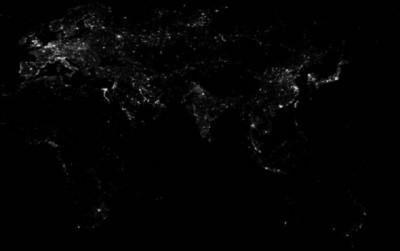 Scientists use satellite data on nighttime light intensity to pinpoint regional favoritism.
Scientists use satellite data on nighttime light intensity to pinpoint regional favoritism. (Source: Image and Data processing by NOAA's National Geophysical Data Center.
DMSP data collected by the US Air Force Weather Agency.)
Researchers at Monash University and the University of St Gallen have used satellite data on night-time light intensity and information about the birthplaces of political leaders in 126 countries to pinpoint regional favoritism.
Using the satellite data from from 38,427 subnational regions from 1992-2009, the scientists established a strong relationship between light intensity and regional GDP.
SEE ALSO: Unconventional Energy Can Change Global Geopolitical Balance
Dr Paul Raschky from the Monash Center for Development Economics and Sustainability said previous research had confirmed the connection between economic activity and light generated at night. But relating night-time light intensity to information about the birthplaces of politicians gave new insights into what determines regional favoritism.
“Our results suggest that being the leader’s birthplace increases night-time light intensity and regional GDP by around four and one per cent respectively,” Dr Raschky said.
The large sample of countries in the study included both democracies and autocracies.
Zaire’s former dictator Mobutu Sese Seko provided an extreme example of the phenomenon, Dr Raschky said. Mobutu had bank accounts and properties all over the world, but spent his money most lavishly in his remote hometown of Gbadolite.
“Mobutu built a huge palace complex costing millions of dollars, luxury guesthouses, an airport capable of handling Concords, and had the country’s best supply of water, electricity and medical services,” Dr Raschky said.
“The satellite imagery over the Gbadolite region clearly showed the rise of Mobutu, starting off with very little night-time light intensity through to extremely high levels during his reign, then easing off once he was no longer in power.”
Similar effects were noted elsewhere, with any benefits gained by favored regions unlikely to be sustained beyond a change in government. Inevitably, such favoritism was most common in countries with weak political institutions and poorly educated citizens.
“Sound political institutions and education are socially desirable and help keep political leaders accountable,” Dr Raschky said.
“We demonstrate their importance in constraining regional favoritism. The enforcement of term limits also seems to be a crucial aspect.”
The researchers also looked at the effect of regional favoritism on the distribution of foreign aid and oil rents.
“Our findings suggest that donor agencies need to be very cautious when supporting countries with authoritarian leaders because such leaders mainly use foreign aid to the benefit of themselves, their family and clan members, and others living in their stronghold,” Dr Raschky said.
He hopes his new approach will aid future research on regional favoritism and the political economy of regional development.
Hodler, R., & Raschky, P. (2014). Regional Favoritism The Quarterly Journal of Economics, 129 (2), 995-1033 DOI: 10.1093/qje/qju004
